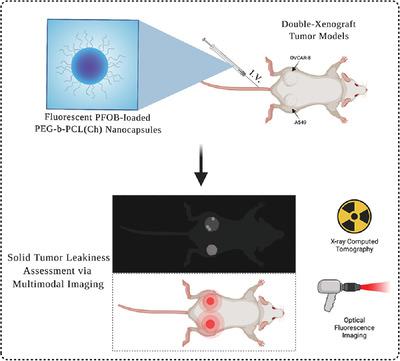当前位置:
X-MOL 学术
›
Adv. Therap.
›
论文详情
Our official English website, www.x-mol.net, welcomes your feedback! (Note: you will need to create a separate account there.)
Imaging Tumor Heterogeneity and the Variations in Nanoparticle Accumulation Using Perfluorooctyl Bromide Nanocapsule X-Ray Computed Tomography Contrast
Advanced Therapeutics ( IF 4.6 ) Pub Date : 2022-04-16 , DOI: 10.1002/adtp.202200047 André O'Reilly Beringhs 1 , Dennis Ndaya 2 , Reuben Bosire 3 , Rajeswari M. Kasi 2, 3 , Xiuling Lu 1
Advanced Therapeutics ( IF 4.6 ) Pub Date : 2022-04-16 , DOI: 10.1002/adtp.202200047 André O'Reilly Beringhs 1 , Dennis Ndaya 2 , Reuben Bosire 3 , Rajeswari M. Kasi 2, 3 , Xiuling Lu 1
Affiliation

|
Systemically administered nanoparticles can extravasate into solid tumors through active or passive processes, showing high inter- and intraindividual variability, leading to inconsistent nanomedicine disposition in tumor lesions and variable therapeutic outcomes. Radio-opaque Perfluorooctyl bromide-loaded PEGylated cholesteryl-functionalized polycaprolactone (PEG-b-PCL(Ch)) nanocapsules (PFOB NC) are assessed as imaging probes via X-ray Computed Tomography (CT) as means to estimate nanoparticle disposition in solid tumors. This imaging platform can enable precision medicine by screening tumors for likelihood of nanoparticle accumulation prior to treatment. Single- and double-lateral xenograft models are employed for imaging-based nanoparticle accumulation assessment using a preclinical multimodal imaging system. Differences in tumor accumulation and spatial distribution are verified as a function of xenograft type via X-ray CT and further corroborated by optical imaging. Slow growing OVCAR-8 xenografts display granular distribution pattern and higher levels of PFOB NC disposition on a volume-normalized basis. A549 xenografts, displaying faster growth, are less susceptible to PFOB NC accumulation and show only a diffuse-like spatial distribution of the nanocapsule contrast. A direct correlation between tumor dispositions of PFOB NC and a commercial PEGylated liposomal doxorubicin formulation is found. This study highlights the potential of using nanoparticle-based radio-opaque contrasts to better understand nanoparticle disposition and foster improved therapeutic outcomes in cancer nanomedicine.
中文翻译:

使用全氟辛基溴纳米胶囊 X 射线计算机断层扫描对比成像肿瘤异质性和纳米颗粒积累的变化
全身给药的纳米颗粒可以通过主动或被动过程渗入实体瘤,显示出个体间和个体内的高度变异性,导致纳米药物在肿瘤病变中的分布不一致和不同的治疗结果。不透射线的全氟辛基溴负载聚乙二醇化胆固醇官能化聚己内酯 (PEG- b-PCL(Ch)) 纳米胶囊 (PFOB NC) 通过 X 射线计算机断层扫描 (CT) 评估为成像探针,作为估计实体瘤中纳米粒子分布的手段。该成像平台可以通过在治疗前筛查肿瘤纳米颗粒积累的可能性来实现精准医疗。单侧和双侧异种移植模型用于使用临床前多模态成像系统进行基于成像的纳米颗粒积累评估。通过 X 射线 CT 验证肿瘤积累和空间分布的差异是异种移植物类型的函数,并通过光学成像进一步证实。生长缓慢的 OVCAR-8 异种移植物在体积标准化的基础上显示出颗粒分布模式和更高水平的 PFOB NC 处置。A549 异种移植物,显示出更快的生长,不太容易受到 PFOB NC 积累的影响,并且仅显示纳米胶囊对比度的扩散状空间分布。发现 PFOB NC 的肿瘤分布与商业 PEG 化脂质体多柔比星制剂之间存在直接相关性。这项研究强调了使用基于纳米粒子的不透射线对比剂来更好地了解纳米粒子的分布和促进癌症纳米医学治疗结果的潜力。
更新日期:2022-04-16
中文翻译:

使用全氟辛基溴纳米胶囊 X 射线计算机断层扫描对比成像肿瘤异质性和纳米颗粒积累的变化
全身给药的纳米颗粒可以通过主动或被动过程渗入实体瘤,显示出个体间和个体内的高度变异性,导致纳米药物在肿瘤病变中的分布不一致和不同的治疗结果。不透射线的全氟辛基溴负载聚乙二醇化胆固醇官能化聚己内酯 (PEG- b-PCL(Ch)) 纳米胶囊 (PFOB NC) 通过 X 射线计算机断层扫描 (CT) 评估为成像探针,作为估计实体瘤中纳米粒子分布的手段。该成像平台可以通过在治疗前筛查肿瘤纳米颗粒积累的可能性来实现精准医疗。单侧和双侧异种移植模型用于使用临床前多模态成像系统进行基于成像的纳米颗粒积累评估。通过 X 射线 CT 验证肿瘤积累和空间分布的差异是异种移植物类型的函数,并通过光学成像进一步证实。生长缓慢的 OVCAR-8 异种移植物在体积标准化的基础上显示出颗粒分布模式和更高水平的 PFOB NC 处置。A549 异种移植物,显示出更快的生长,不太容易受到 PFOB NC 积累的影响,并且仅显示纳米胶囊对比度的扩散状空间分布。发现 PFOB NC 的肿瘤分布与商业 PEG 化脂质体多柔比星制剂之间存在直接相关性。这项研究强调了使用基于纳米粒子的不透射线对比剂来更好地了解纳米粒子的分布和促进癌症纳米医学治疗结果的潜力。



























 京公网安备 11010802027423号
京公网安备 11010802027423号